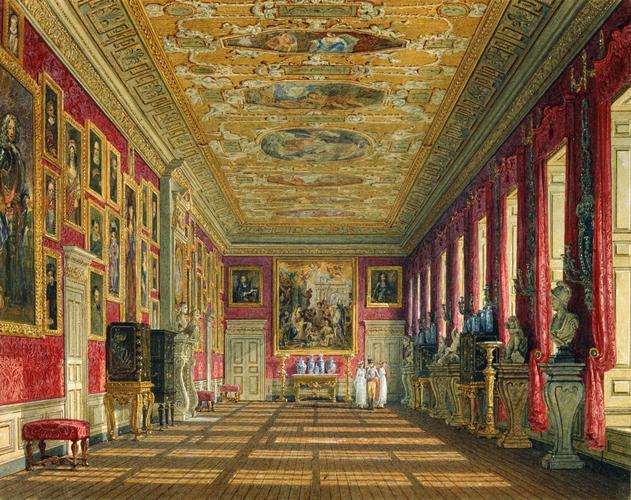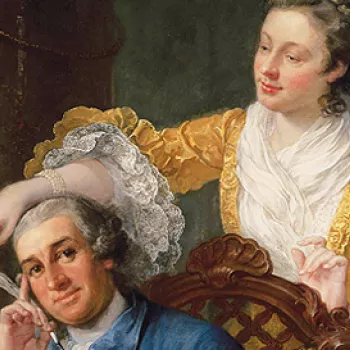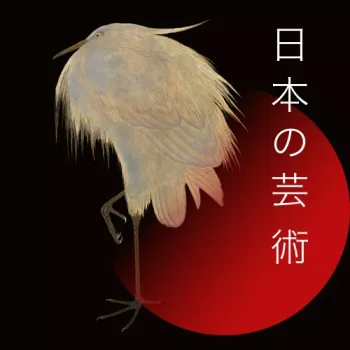Kensington Palace: The King’s Gallery 1816
Watercolour with touches of bodycolour over etched outlines | 19.8 x 25.0 cm (sheet of paper) | RCIN 922158
-
A watercolour of The King's Gallery at Kensington, a luxury handcoloured version of one of the plates from William Henry Pyne's History of the Royal Residences (1816-1819). The King’s Gallery is the principal room on the second floor of the south-facing block built at Kensington in 1695-6 as part of the first wave of William and Mary’s works. It was approached via Wren’s great staircase to the north-west (the King’s Stair), and runs east-west, lit by a line of windows on the south wall. Doors at the far end lead into closets and thence into the remainder of the King’s Apartments.
The Gallery is still used today as originally intended (and as shown here) - for the display of paintings. Wild’s view records the appearance of the Gallery following redecoration by William Kent for George I in 1725-7: the chimneypiece (surmounted by William III’s wind-dial), doorcases, ceiling (painted with scenes from the Odyssey), and crimson damask used for the wall-hangings and curtains, all date from that period.
However, by the time of Wild’s view the original picture hang - with matching Palladian frames - had been replaced by a miscellaneous assemblage. The painting on the end wall - Sebastiano Ricci’s Adoration - was acquired by George III with Smith’s collection and was later moved to Hampton Court. The image also shows Japanese cabinets between the windows which display groups of blue-and-white porcelain, likely to be from the period of George II and Queen Caroline's occupation. In 1993-4 the crimson silk was reintroduced, the woodwork was repainted, and some of the paintings which hung in the King’s Gallery at the time of Kent’s changes were returned, in their uniform architectural frames.
The paintings in this image can be identified with reference to the 1818 inventory of Kensington Palace; on the left verge is the full length portrait of Charles, Margrave of Brandenburg-Ansbach (406795); above it perches the small Seisenegger portrait of Maria Christina, Archduchess of Austria (402956), the stack of three paintings to its right has Savoldo’s Man in Armour (405770), over Georges de la Tour’s Saint Jerome (405462), over North Italian, Man with Books (406112). The overdoor is Hanneman’s portrait of Mary of Orange (405877). The next three portraits place Miereveld, Man with Shell (403956), over Spanish, Man with a Sword (405565), over after Jacopino del Conte, Michelangelo (402664). To the right a stack of two sees an Italian portrait of a man (406148) over Wright’s James, Duke of Cambridge (404330); the anonymous full length of the Margravine of Brandenburg-Ansbach (406794) has another Seisenegger Austrian Archduchess above it, this time Elizabeth (402955). The next two stacks of paintings become a bit conjectural and in the far half of the Gallery only the pattern of frames is visible.
On the end wall we are on safer ground recognising the two overdoors, Kerseboom’s Robert Boyle (left, 405637) and Wissing’s Charles II (405881), framing Sebastiano Ricci’s huge Adoration of the Kings (405743).
Catalogue entry adapted from George III & Queen Charlotte: Patronage, Collecting and Court Taste, London, 2004 and Japan: Courts and Culture (2020)Provenance
Probably acquired by George IV
-
Creator(s)
Acquirer(s)
-
Medium and techniques
Watercolour with touches of bodycolour over etched outlines
Measurements
19.8 x 25.0 cm (sheet of paper)
Other number(s)
RL 22158Alternative title(s)
The King's Gallery, Kensington Palace.











